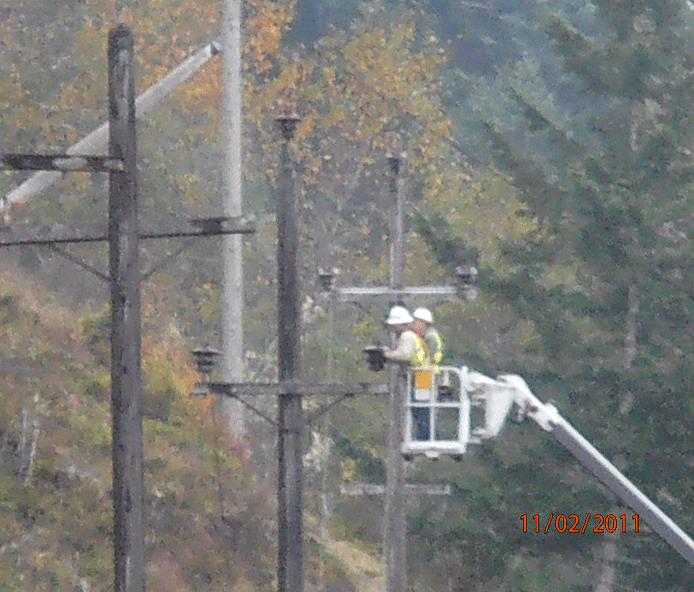
Transmission Lines Gone; Elwha Powerhouse Going Contractors continue to make progress on Elwha River Restoration, even during this 'fish window' (when contractor-caused sediment releases are banned.) Elements of the work that do not affect water quality are still ongoing. Elwha Dam Glines Canyon Dam Electric Transmission Line Removal 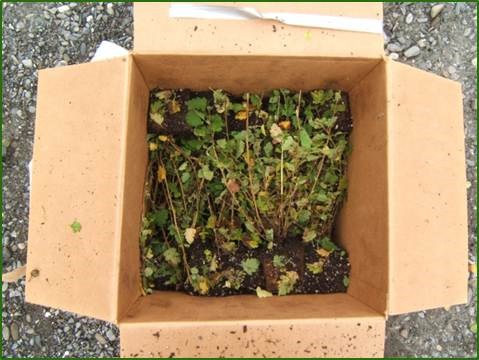
Revegetation Begins! November's cool and damp weather creates good planting conditions for young native plants, and revegetation of the former Elwha reservoir lake beds began last week. On November 8, park staff, volunteers and a six-person Washington Conservation Corps (WCC) crew moved 60 boxes of native plants from the Matt Albright Native Plant Center in Robin Hill Farm Park to Lake Mills. The following two days, the crew planted approximately 2,300 native plants in newly exposed sediments of upper Lake Mills. Another 10,000 plants are planned for installation later this month and early December. An additional 18,000 plants will be installed at three more sites in January and February. In all, 24,850 container-grown native plants were produced this year by park at the Native Plant Center. Forty-four species of plants are represented, including trees, shrubs and forbs. An additional 5,000 Douglas-fir and 2,600 bare-root shrubs and trees were produced by commercial growers for the project this year. See below for photos and more info and learn more about the Elwha River Restoration Revegetation Plan. 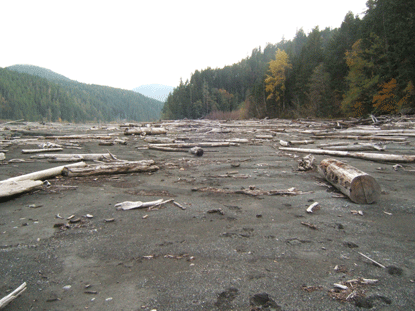
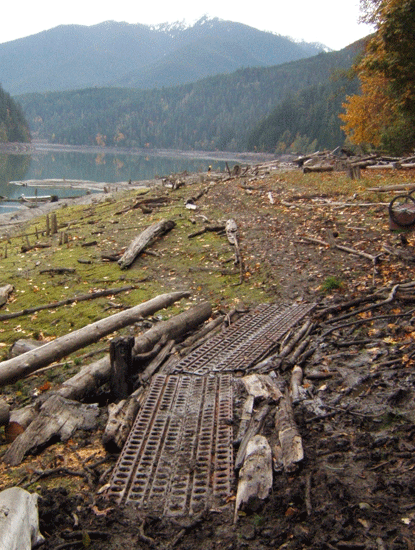
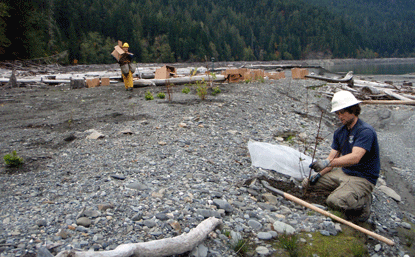
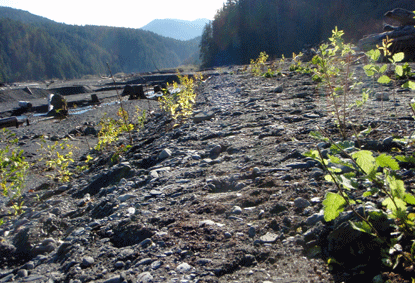
October 20, 2011 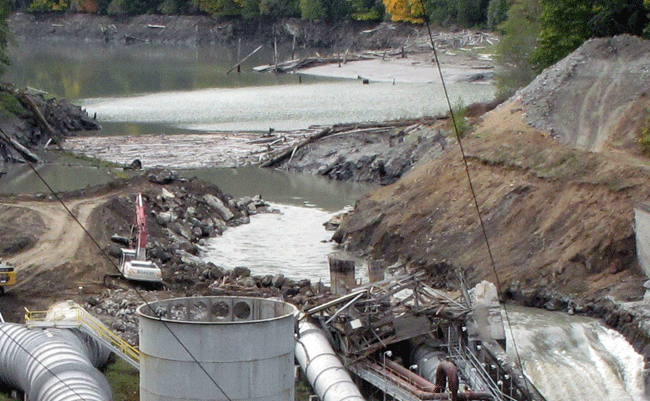
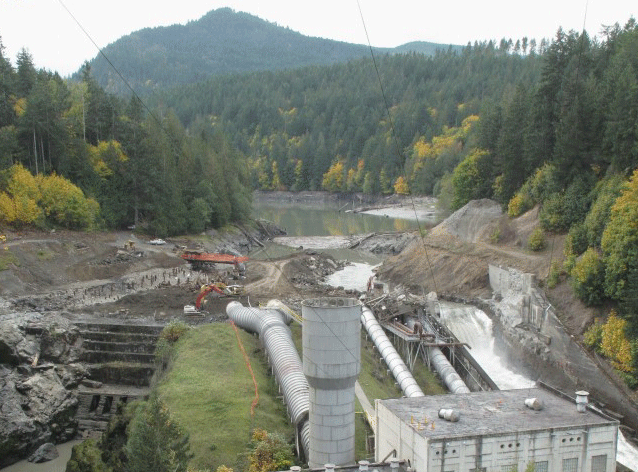
The new diversion channel at the Elwha Dam is finished, and yesterday morning, crews opened the coffer dam above it. The photo at right shows the river flowing through the new channel. Thanks to videographer and Olympic NP volunteer, John Gussman, for sharing this time-lapse series of film clips. In the space of less than 90 seconds, John shows us the 3-hour transition from the old channel to the new. (Side note: John filmed these clips from the Elwha Dam Overlook trail, a ten-minute walk from the trailhead parking lot on Lower Dam Road.) Effective immediately, the exposed reservoir areas of Lake Aldwell and the remaining Lake Aldwell are closed to public use. This emergency closure is designed to protect the public from hazardous conditions caused by the draining of Lake Aldwell and removal of the Elwha Dam and associated structures. The log boom that prevents boats from drifting over the dam will be removed at 2:00 p.m. tomorrow, October 21. Without the log boom, there is no barrier between the remaining reservoir and the swiftly moving river as it flows over and down the new diversion channel. These factors make the area around the dam extremely unsafe for boating and other forms of recreation. Once the log boom is removed, the raft of large logs behind it will move downstream with the river. Anglers and other downstream river users are urged to use caution around the river in the coming days and to be on the lookout for logs moving downstream. The historic slack waters of Lake Aldwell are changing to a delta environment with swift water conditions. River channels with steep banks are changing rapidly, are unpredictable, and hazardous to visitors. Access around the remaining reservoir is therefore closed to vehicle, bicycle, foot traffic, and boating. However, boaters and rafters coming down the Elwha River may enter the extreme upper reaches of the reservoir to take out. Camping, extended stays, or loitering in the area is prohibited. Within the next several days, workers will begin moving construction equipment onto Whiskey Bend Road so that repairs to last year's slide can begin. All access to the Whiskey Bend Road, including pedestrian, is now prohibited beyond the intersection with Olympic Hot Springs Road. The road is scheduled to reopen to vehicle traffic in December. Upcoming at Elwha Dam Demolition of the penstocks will continue through the coming week. (The "penstocks" are the large metal pipes leading from the dam to the powerhouse.) The penstocks themselves are currently being evaluated for possible asbestos content; once the level of this hazardous material has been determined, contractors will proceed with the appropriate removal method. Upcoming at Glines Canyon Dam Crews will continue removal of power lines and power poles over the next three weeks. Intermittent power outages are planned, including one scheduled for the Elwha Valley area of Olympic National Park on Wednesday, October 26 from 8:00 a.m. to 4:00 p.m. The temporary power shutdown will allow workers to safely dismantle old transmission lines and poles associated with the dams. October 20, 2011 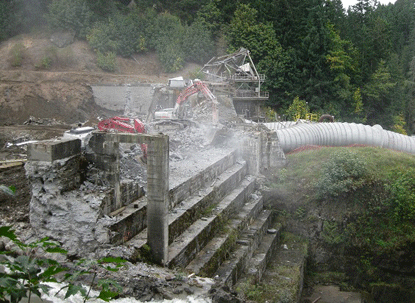
Diversion Channel Nearing Completion Crews are now clearing the broken concrete and bedrock left by the blast. The upstream earthen portion of the diversion channel is also nearly done. The gravity section of the dam (the 'stair-step' structure seen in the photo above) has also been lowered this past week. Removal activities and lowering of the dams will occur through the end of October, but contractors will shift to other activities beginning November 1. From November 1 through December 31, contractor activities will concentrate on removal of penstocks, powerhouses and other elements of the project that will not affect river flows. This includes continue removal of the gravity section of the dam (seen above) and the left forebay area, both of which will be 'in the dry' when the river flow shifts to the new diversion channel. Upcoming at Elwha Dam As work continues on the diversion channel, the "penstock intake structures" will be demolished. (The "penstocks" are the large metal pipes leading from the dam to the powerhouse - the "intake structures" connect the penstocks to the dam.) Glines Canyon Dam Removal of electric transmission lines began today. 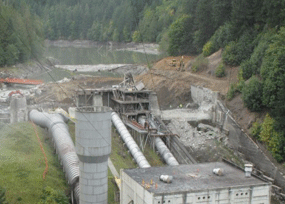
Excavation of Diversion Channel Ongoing at Elwha Dam Removal continues on both the Elwha and Glines Canyon Dams. Removal activities and lowering of the dams will occur through the end of October, but contractors will shift to other activities beginning November 1. On that date, one of three annual "fish windows" begins, meaning that dam lowering and sediment release may not occur during critical periods for the river's fish populations. From November 1 through December 31, contractor activities will concentrate on removal of penstocks, powerhouses and other elements of the project that will not affect river flows. Upcoming at Elwha Dam The Elwha Dam Overlook Trail will close for approximately an hour during all blasting operations to maintain visitor safety and site security. Excavation of the upstream earthen portion of the diversion channel will continue through next week too. Beginning the week of October 17, contractors will breach the existing cofferdam and the river will flow through the new diversion channel. Drawdown of the Lake Aldwell reservoir will begin that week and continue until the reservoir reaches elevation 167. Flows are estimated to increase by approximately 150 cubic feet per second (cfs). Once the water level reaches 167 (approximately October 23), that level will be maintained for 14 days. As work continues on the diversion channel, the "penstock intake structures" will be demolished. (The "penstocks" are the large metal pipes leading from the dam to the powerhouse - the "intake structures" connect the penstocks to the dam.) Glines Canyon Dam In the coming week, contractors will lower the Lake Mills reservation level approximately ten feet, dropping the water from its current level of approximately 572 feet to 560 feet by around October 14. Once the 560 foot elevation is reached, it will be held steady for 14 days while the un-notched, high and dry sections of the dam are chiseled away. Meanwhile, demolition of the transmission lines associated with the dams and powerplants is scheduled to begin by next week. 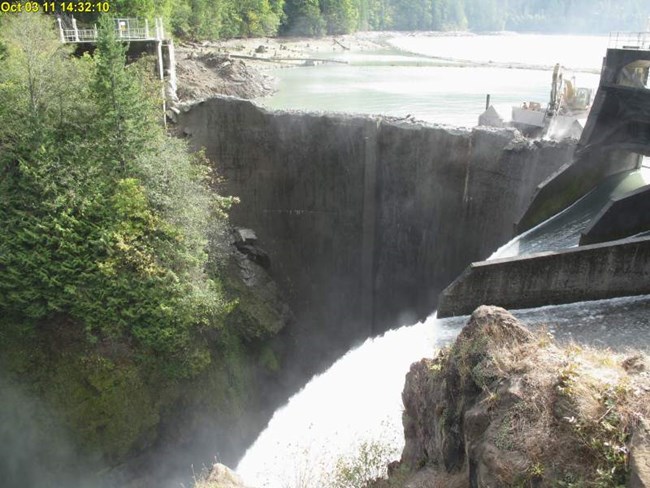
October 3, 2011
Whiskey Bend Road to Close to All Use for October Repairs When repairs begin in October, Whiskey Bend Road will close to all use-motorists, pedestrians, bicyclists, and stock users-for approximately 45 days. 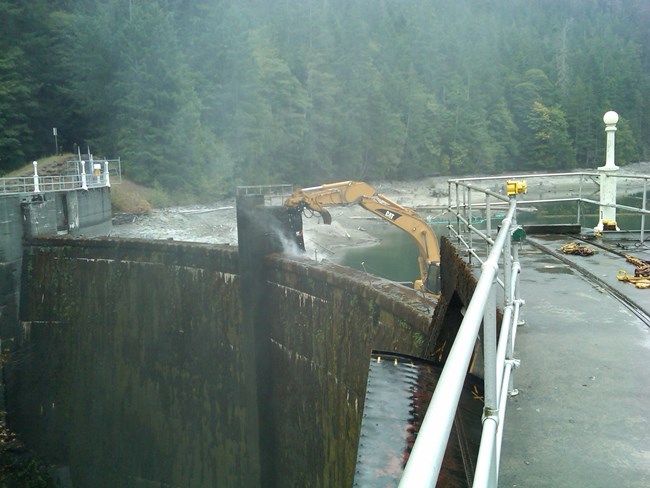
Dam Removal Begins on the Elwha River
Official Commemoration of Elwha River Dam Removals Happens September 17; Live Streaming of Ceremony Starts at 10:30 A.M. at CelebrateElwha.com September 15, 2011 The official ceremony marking the beginning of dam removal will take place September 17 at 11 a.m., at Elwha Dam along the northwest shore of Lake Aldwell. A live simulcast will begin at 10:30 at CelebrateElwha.com, and a big screen showing of the ceremony will take place at the Port Angeles City Pier and at the Mountaineers Outdoors Fest in Seattle. Governor Chris Gregoire, Lower Elwha Klallam Tribal Chairwoman Frances Charles, Secretary of the Interior Ken Salazar, Assistant Secretary for Indian Affairs Larry Echo Hawk, Senators Patty Murray and Maria Cantwell and Rep. Norm Dicks will participate in the ceremony, along with NPS Director Jon Jarvis and Bureau of Reclamation Commissioner Michael Connor. Actor Tom Skerritt, who serves on the board of the nonprofit organization American Rivers will emcee the event with Olympic National Park Superintendent Karen Gustin. Showcasing the first steps of dam removal, an excavator will remove the first concrete from the Elwha Dam. The ceremony will include musical interludes by singer/songwriters Eliza Gilkyson and Dana Lyons, who will each perform an original work. The Lower Elwha Klallam Tribal dancers and students from Port Angeles High School will also perform.
Webcams Installed to Enable Public Viewing of Removal Process September 12, 2011 Six webcams have been installed along the Elwha River, just as the dam removal phase of the Elwha River Restoration project begins. An easy-to-find webcam link is featured on Olympic National Park's web page for Elwha River Restoration. The webcams were installed by a National Park Service contractor last week facing both the Elwha and Glines Canyon Dams, the deltas at the southern ends of the Lake Aldwell and Lake Mills reservoirs, and along the northern shore of each reservoir. While the primary purpose of the webcams is to monitor the process of sediment movement, viewers will be able to get a direct view of each dam as the removal process progresses. "This week's start of dam removal and the ongoing restoration work on the river has generated interest regionally, nationally and even internationally. We think this is a unique and effective way to reach out to people interested in the Elwha River and its restoration," said Olympic National Park Superintendent Karen Gustin. "Olympic National Park is pleased to see these cameras go online this week. Please visit the page and check back regularly to keep track of these exciting changes." Glines Canyon Receives Major Equipment Delivery; Contractor to Install Cofferdam at Elwha The contractors' Notice to Proceed for removal of the dams will be September 15 for Glines Canyon Dam and September 19, 2011 at Elwha Dam, following the September 17 commemoration at Elwha. Progress at Glines this week included delivery and assembly of a Manitowoc 4100 crawler crane with 200' of boom and a maximum lifting capacity of 230 tons. The delivery required nine loads of crane parts, including a 175-ton support crane to assemble the 4100, to be trucked in through the Elwha Valley via Olympic Hot Springs Road. Meanwhile, employees of Staton Company, a subcontractor to Barnard Construction, worked towards disassembly of the transformer yard at Glines. That demolition work continues this week. Another step towards dam removal is now ready to begin at Elwha Dam. A cofferdam will be installed across the forebay in order to divert river flow toward the left diversion channel, which has yet to be excavated. Barnard expects the cofferdam to be in place before the September 17 dam removal commemoration.
Reclamation Continues Decommissioning Process; Update on Contractor Activities August 5, 2011 U.S. Bureau of Reclamation employees continue the process of decommissioning Glines Canyon Dam, after finishing at Elwha Dam in July. The Glines Canyon decommissioning is expected to be completed by mid-September. With decommissioning finished at the Elwha Dam, contractors have begun their preparations for the start of dam removal on September 15. Temporary offices have been installed, several trees have been removed along Lower Dam Road and the road has been widened to better accommodate truck traffic along the road over the next three years. Asbestos abatement also continues at the Elwha Dam site. To date, Barnard has subcontracted work to a number of local-area firms. From Port Angeles, those include Bruch and Bruch Construction Inc., Northwestern Territories Inc., Straits Electric, Pacific Office Equipment Inc., Star Welding & Wrenching, N C Power Systems, and United Rentals. D&H Enterprises from Forks, Washington is also a Barnard subcontractor, along with Clark Land Offices PLLC from Sequim, Washington. A listing of subcontractors for the four largest Elwha River Restoration construction projects has been prepared by the National Park Service's Denver Service Center. Barnard officials estimate that approximately 40 workers, including 12-14 of its own personnel, will be employed at the dams during the removal phase. Elwha River Restoration has already created significant employment through large-scale construction projects over the last few years. It is estimated that the largest contract, for construction of the Elwha Water Facilities, had an average of 83 workers from April 2008 to December 2009. Construction of the Port Angeles Water Treatment Plant, was estimated to have an average of 40 workers between January 2008 and December 2009. The Lower Elwha Klallam Tribe Fish Hatchery was estimated to have an average of 29 on-site workers during its construction from January 2010 through May 2011.
Preparations Begin for Start of Dam Removal Phase July 5, 2011 This is the first in what we anticipate will be bi-weekly construction - or deconstruction - updates. We plan to use this space to share details on the dam removal project, as a way to keep the public informed on the progress over the next three years. Major removal work on the Elwha and Glines Canyon dams doesn't start until September, but key Barnard Construction staff members are on site in Port Angeles and preliminary work has already begun. Fisherman's Corner road repairs are now complete. Over approximately four weeks in June, subcontractors Bruch and Bruch, Inc. and Lakeside Industries (both of Port Angeles) repaired damage caused by slumping of the riverbank and road by placing bank protection, replacing road base material and re-paving several sections of the road along a 2000-foot stretch. This upgrade was necessary not only to accommodate the increased truck traffic that will soon be heading to and from Glines Canyon Dam, but also to provide continued visitor safety in the Elwha Valley. The road looks great and we were glad to have it back open, just in time for the Fourth of July. On July 5, contractors will lock the gate on Lower Dam Road which leads down to the Elwha Dam. This closure is tied to minor road upgrades and the removal of hazardous materials from the Elwha site. Public and employee safety is of paramount importance, both for Barnard and for the National Park Service. Stay tuned. |
Last updated: February 1, 2022
